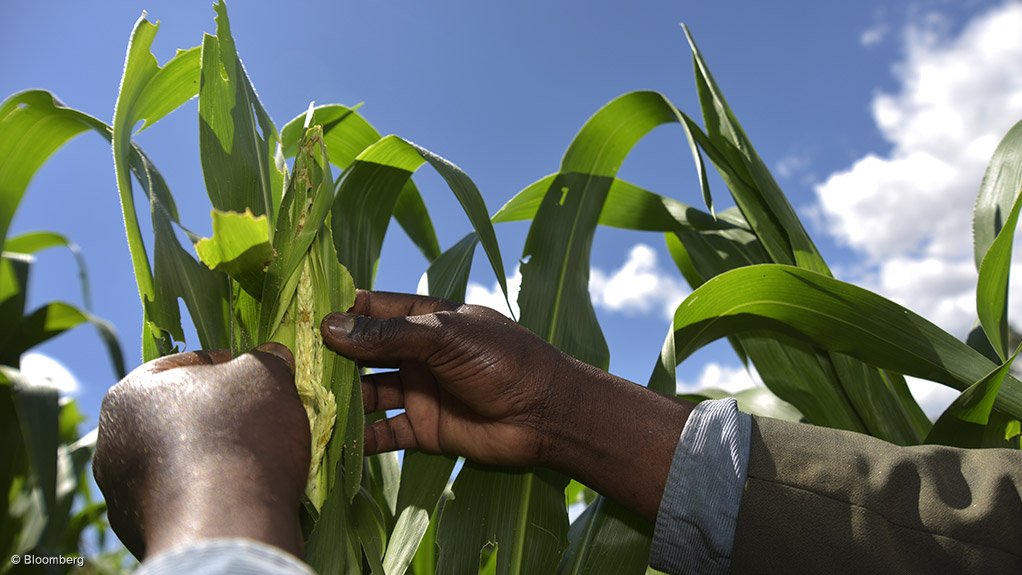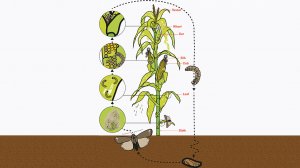App monitors spread of FAW in Africa



PEST ARMY The invasion of the fall armyworm is threatening the food security of 300-million people in Africa
Photo by Bloomberg
LIFE CYCLE The fall armyworm has a 25 to 30 day life cycle
Photo by Centre for Agriculture and Bioscience International
The Fall Armyworm Monitoring and Early Warning System (FAMEWS) application (app) can save 300-million people in Africa from food insecurity and prevent significant economic losses in maize of up to $4.8-billion, caused by the infestation of the fall armyworm (FAW), says Food and Agriculture Organisation of the United Nations (FAO) senior agricultural officer Keith Cressman.
The FAW can feed on more than 80 crops, including rice, sorghum, millet, sugar cane, vegetable crops and cotton; however, its preferred crop is maize. The FAW is native to South America and was first noticed in West Africa in 2016. It has since spread to nearly all sub-Saharan countries in Africa, and is now poised to move into countries of North Africa.
The FAO launched the FAMEWS app in March to monitor the spread of the FAW in Africa as well as the different management methods farmers are using, and is testing another app, Nuru, to assist in educating farmers on the pest and how to identify it, Cressman tells Engineering News.
The FAMEWS app has been deployed to 45 countries in sub-Saharan Africa. Madagascar, Mozambique, Malawi, Zambia and Zimbabwe are among the numerous countries using the FAMEWS app.
The FAMEWS app collects data in terms of where the FAW is found and potential management methods, while Nuru helps to identify the pest and educate farmers about the FAW.
Neither app requires Internet or network connection, meaning farmers can collect data in remote regions. Once they are in an area with network or Internet connection, data can be sent to a global platform that maps the current situation in Africa.
The Nuru app, created by the FAO and Pennsylvania State University, in the US, uses a mobile phone camera to identify damage to crops caused by the FAW. It does not require farmers to take a photo, Cressman adds.
FAO is using the existing Farmer Field Schools (FFS) – a group-based learning process that is used by a number of governments, nongovernmental organisations and international agencies – and other channels to promote integrated pest management, to disseminate information about the FAW, and train farmers and agricultural extension agents to use the FAMEWS app. The organisation aims to reach 10-million farmers through 40 000 FFS over five years.
Concerns about the FAW
A major concern for countries is that the FAW is a robust, highly migratory pest that will never be eradicated in Africa.
“The FAW is not like a locust – it does not invade and then disappear – it will be a resident pest that African farmers will continue to face,” reiterates Cressman.
Further, prior to the FAMEWS app, nobody knew exactly where the FAW was in different countries.
“Now there is a better idea of the FAW; it is not complete but it is significantly better and improving every week,” Cressman maintains.
FAW management decisions at local and national levels in sub-Saharan African countries are now based on preliminary data collected through the app, which is helping national governments to prioritise their actions by identifying the areas that need assistance, Cressman claims.
“We want to start looking at the relationships between the presence of the FAW and different farming methods, and understand how the FAW reacts,” he highlights.
The FAO is encouraging farmers to try different farming methods and control methods amid the threat of FAW to find the best methods to manage the pest while protecting natural enemies of the FAW such as predators and pathogens.
“There are methods that are working, so farmers are not in a hopeless situation,” he adds.
Managing the FAW
The first phase in managing an FAW infestation is checking the crops as soon as they emerge. Farmers are encouraged to go through their fields to search for egg clusters that contain several hundred eggs, but are easy to destroy.
“While it is labour intensive, it is nearly 100% effective,” Cressman claims. “By simply using your thumb, several hundred future caterpillars have been killed.” This method is cheap and safe, as it does not require pesticides or harmful chemicals as the eggs are destroyed by hand.
However, if the farmers do not manage to destroy the eggs, they can focus on the caterpillars that are not yet in the whorl of the maize plant. “The farmers can apply a lot of traditional control techniques, such as hot pepper spray, soap and water spray, and neem oil extract,” Cressman highlights.
If there has been rain, the water accumulates in the whorl and drowns the worms. In addition, farmers are exploring other local methods, such as placing ash or sand in the whorl, to suffocate them, he explains. Unlike chemical pesticides, all these techniques are safe for the environment and do not disrupt the natural enemies of the FAW that, if allowed to flourish, should be able to keep the FAW under control.
The FAMEWS app is currently available on Android version 6 or higher phones in English, French, Portuguese, Arabic, Amharic, Swahili, Oromo, Kinyarwanda and Swati. It is being translated into other local languages to help spread and broaden the use of the app in all countries of Africa to better understand and manage this new pest in Africa.
Article Enquiry
Email Article
Save Article
Feedback
To advertise email advertising@creamermedia.co.za or click here
Announcements
What's On
Subscribe to improve your user experience...
Option 1 (equivalent of R125 a month):
Receive a weekly copy of Creamer Media's Engineering News & Mining Weekly magazine
(print copy for those in South Africa and e-magazine for those outside of South Africa)
Receive daily email newsletters
Access to full search results
Access archive of magazine back copies
Access to Projects in Progress
Access to ONE Research Report of your choice in PDF format
Option 2 (equivalent of R375 a month):
All benefits from Option 1
PLUS
Access to Creamer Media's Research Channel Africa for ALL Research Reports, in PDF format, on various industrial and mining sectors
including Electricity; Water; Energy Transition; Hydrogen; Roads, Rail and Ports; Coal; Gold; Platinum; Battery Metals; etc.
Already a subscriber?
Forgotten your password?
Receive weekly copy of Creamer Media's Engineering News & Mining Weekly magazine (print copy for those in South Africa and e-magazine for those outside of South Africa)
➕
Recieve daily email newsletters
➕
Access to full search results
➕
Access archive of magazine back copies
➕
Access to Projects in Progress
➕
Access to ONE Research Report of your choice in PDF format
RESEARCH CHANNEL AFRICA
R4500 (equivalent of R375 a month)
SUBSCRIBEAll benefits from Option 1
➕
Access to Creamer Media's Research Channel Africa for ALL Research Reports on various industrial and mining sectors, in PDF format, including on:
Electricity
➕
Water
➕
Energy Transition
➕
Hydrogen
➕
Roads, Rail and Ports
➕
Coal
➕
Gold
➕
Platinum
➕
Battery Metals
➕
etc.
Receive all benefits from Option 1 or Option 2 delivered to numerous people at your company
➕
Multiple User names and Passwords for simultaneous log-ins
➕
Intranet integration access to all in your organisation



















